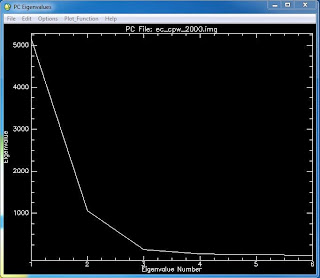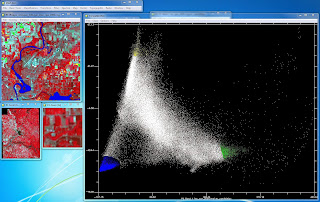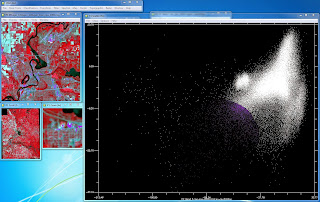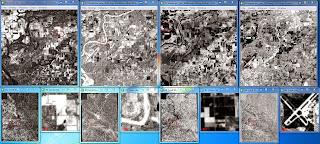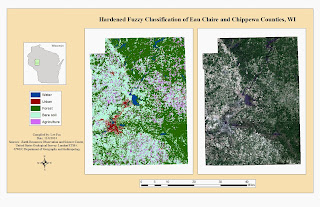Multiple classification methods have been used throughout the semester including supervised, unsupervised, and fuzzy logic, each having its advantages and disadvantages. However, none of these methods has created a classification with suitable accuracy for use in further analysis. Two advanced classifiers, expert tree and neural network, have the potential to reach a level that exceeds the minimum accepted overall accuracy for classified images (85%). Both of these classifiers are used and discussed in this lab exercise.
- Background -
Expert tree, or expert system, classification employs ancillary data to improve on an already classified image. An expert system is comprised of three parts: hypotheses, rules, and conditions. A hypothesis is a terminal (or intermediate) informational class (such as water or forest) and is connected to a rule. Rules are written by the analyst to allow specific communication between the hypotheses and the previously classified image and ancillary data. These rules can be implicit, explicit, conditional or Boolean. Conditions are statements that define a new classification based on its connected rule(s) and hypothesis. The types of ancillary data that can be used are numerous and include zoning, elevation, vegetation, temperature, and soil data. Extensive knowledge of the study area is recommended.
Neural Networks attempt to simulate the human brain when classifying an image. Through back-propagation, a number of iterations pass back and forth from input layers to a result until a user defined error threshold is reached. The connections between the input layers and the result are called hidden layers. As iterations pass through the hidden layers, weights are developed and modified in response to the error present in the currently generated result. Reflective remote sensing data and ancillary data are used as inputs for neural networks and the result can be modified by changing the parameters of then neural network like training rate and training momentum.
- Methods -
 |
| Image 1: The finished classification tree. Hypotheses > Rules > Conditions |
A previously classified image of Eau Claire, Chippewa Falls, and the City of Altoona, WI was enhanced through use of census and elevation data in an expert system classification with ERDAS IMAGINE 2010. The classification tree was created by navigating to Raster > Knowledge Engineer. In the knowledge engineer, the hypotheses, rules, and conditions (variables) were added. First, arguments were created to relate five desired terminal classes to the classified image. Then ancillary data was incorporated by creating 3 arguments and counter arguments to reclassify certain erroneously classified land cover. Counter arguments were then added for the terminal classes effected by the 3 arguments created through the ancillary data (residential, green vegetation, and agriculture). The finished classifier (Image 1) was then used to performed expert system classification be selecting 'Knowledge Classifier' in the Knowledge Engineer window. The classifier created 8 classes based on the 8 arguments in the classification tree. The 8 classes were then appropriately merged into the desired 6 terminal classes and made into a map (Map 1).
 |
| Image 2: Graph of the RMSE error for each iteration of the neural network classifier |
A simple classification for a Landsat TM image of the University of Northern Iowa was created through a neural network using ENVI software. Three homogenous regions of interest (ROIs) were created for bare soil, green vegetation, and snow. These ROIs were used to classify the image and the number of iterations was increased to ensure the neural network would reach the error threshold and finish (Image 2).
- Results -
 |
| Map 1: Result of the expert system classification |
 |
| Image 3: Result of the neural network classification. Blue is bare soil, green is green vegetation, and red is snow. |
- Discussion -
The expert system classification was able to increase the accuracy of the classification as well as the number of informational classes. The accuracy increase is seen in green vegetation, agriculture, and urban areas as those were the classes effected by the introduction of ancillary data. Small areas of urban classification are often seen in forested areas, known as the 'salt and pepper effect', and more ancillary data would need to be included to increase the accuracy of the forest classification. The urban classification was enhanced by creating a new class, other urban, through population density data. The distinction between urban and other urban attempts to separate residential areas and other urban features (airport, shopping mall, etc).
The concept of the neural network is intriguing but its use can be limited due to the desired level of complexity and size of the study area in relation to computer resources. The classification developed through the neural network method was simple but seemed to be effective. Just like with other classified images, a neural network classification could be used as input in an expert system to further its accuracy.
- Conclusion -
Two advanced classifiers were used in this lab exercise which produced better classifications (through visual analysis) than the standard classifiers used earlier in the semester. Neural networks attempt to simulate the human brain by relating and processing data many times. An expert system classifier can increase the accuracy of a previously classified image by removing erroneous classifications and creating new sub-classes.
- Sources -
Department of Geography, University of Northern Iowa. Quickbird imagery.
Earth Resources Observation and Science Center, USGS. Landsat imagery.
United States Census Bureau. Census population density data.
